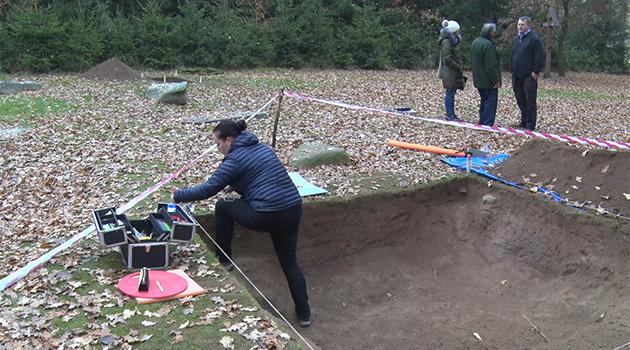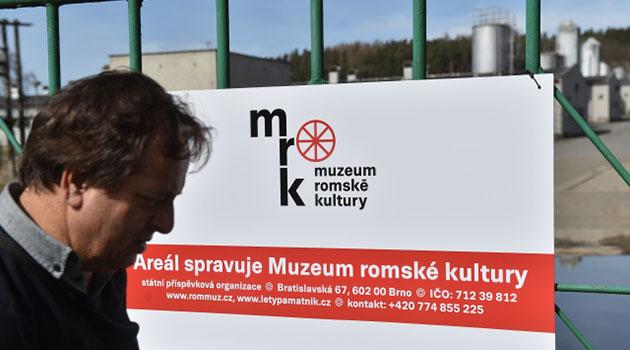Czech archaeological samples yet to find exact location of mass grave at site of the Holocaust of the Roma

At the beginning of November an archaeological survey was performed on the location that until now has been believed to contain the mass graves of the victims of the former “Gypsy Camp” at Lety u Písku. A geophysical survey was also undertaken in the vicinity of the former camp.
An international research team under the direction of Pavel Vařeka from the University of West Bohemia in Plzeň has performed the very first non-invasive archaeological probe ever near the memorial at the place that allegedly served as a mass grave site for the victims of the camp during the Second World War. That survey has demonstrated that at the locations probed near the current memorial, no mass graves have been found yet, and that the uneven surface of the terrain, which to date has been considered to be the site of the graves, has a different explanation.
Luděk Strašák, administrator of remembrance sites for the Museum of Romani Culture, told news server Romea.cz that the implementation of these low-impact probes for the purpose of ascertaining whether mass graves actually are located near the current memorial site was planned at the request of the Committee for the Redress of the Roma Holocaust and were able to be realized thanks to a European Humanities in the European Research Area (HERA) project. “The assumption was that we would find human remains and mass graves, and in such a case a forensic anthropologist from Poland who is creating a genetic database of totalitarian regime victims was prepared to receive a DNA sample for his collection,” Strašák said.
“On the basis of that request by the relatives of those imprisoned here, we were of the opinion that if we did find a sample of DNA, it would be possible to analyze it and then compare it with DNA samples from the surviving relatives. Had we been very lucky, a relational line could have been found,” said the Musuem of Romani Culture site administrator.
“However, because no graves or remains have been found yet, we will have to continue that particular research next year,” Strašák said. At the location of the current memorial, several German cartridges and also the remains of the burnt-down wreckage of the original camp have been found by the probe.
“The same material is here as the material we found during our first survey at the site of the former camp. They must have brought the remains of the burned material from the camp here,” Vařeka told news server Romea.cz directly at the memorial site.
According to the archaeologist, no burial pits were found by this most recent survey at the location of the current memorial. “In just one probe something was found at the corner that could be a burial pit, but another survey must be performed to either confirm or refute that possibility,” he said.
The press conference held on the occasion of presenting these new findings was attended not just by the archaeologist, but also by Čeněk Růžička on behalf of the relatives of the victims. He said that during the 1990s he had accompanied a camp survivor to Lety who said he had participated in the burial during the typhus epidemic.
That survivor had indicated that the location of the mass grave was 150 meters further away from the place where the current memorial is. For that reason, the Committee asked that the survey of the current memorial site be done.
Růžička also expressed the concern that German soldiers may have been buried next to the camp victims on the camp grounds: “At that time it would have been normal for the German soldiers to be buried along with their victims. We also discovered that in Mirovice at the cemetery.”
“They buried German soldiers next to our children, who are interred there right along the cemetery wall. We came across it in the archive and naturally we arranged for the German remains to be removed,” Růžička said.
“They were judicious, they comprehended our request. To bury the murderers at the same location as their victims is something only barbarians would do,” the chair of the Committee for the Redress of the Roma Holocaust told Romea.cz.
In Mirovice the deceased prisoners, predominantly children, were buried at the parish cemetery until the beginning of 1943. The burial ground at the camp itself – the one the archaeologists are now looking for – was opened on 15 January 1943, according to the documentary record.
“Burials began there on 16 January. When the typhus epidemic was reaching its peak at the camp, as many as 10 prisoners a day were dying, most of them children including nursing infants,” the archaeologist said at the press conference.
“The last burial at that location was on 23 April 1943,” the archaeologist said. That same year the camp was razed to the ground and set on fire.
VIDEO
From the history of the concentration camp at Lety u Písku
The original grounds of the facility at Lety u Písku served in the year 1940 as an accommodation facility for construction workers. After that it was used for a disciplinary labor camp on the orders of the Interior Minister of the Government of the Protectorate of Bohemia and Moravia, Josef Ježek, dated 15 July 1940, which was issued on the basis of Czechoslovak Government edict no. 72, “on disciplinary labor camps”, dating from 2 March 1939.
That edict had been promulgated prior to the Nazi occupation. According to the edict, “wandering gypsies capable of work and other vagabonds living that same way, professional beggars, persons living from begging done by others (children, etc.), professional gamblers, notorious bums and loiterers, and persons living from dishonorable profits (prostitution, etc.), whether their own or those of others” were to be forcibly interned in the disciplinary labor camps.
The first 12 prisoners were sent to the one at Lety on 17 July 1940. About 10 % of them were Romani.
On 1 August 1942 the camp was turned into a “Gypsy Camp” and entire Romani families were then forcibly transported there. Lety began to function as a concentration camp on 1 August 1942 and was closed on 4 May 1943.
The camp’s capacity had been increased to make it able to house as many as 600 prisoners, but that number was soon exceeded, as during August 1942 more than 1 100 children, men and women were interned there. The camp was not equipped with the necessary hygienic or other kinds of facilities for such a high number of people.
The prisoners frequently had to bathe in the nearby fish pond. Prior to August 1942, only men had been imprisoned at the facility.
Beginning in August 1942, under absolutely unsatisfactory conditions, children and women were brought to Lety and left there to rot as well. After the big intake in August 1942, those subsequently forced into the camp arrived there just a family or an individual at a time.
At least 326 people died directly in the camp at Lety, 241 of them children. There were 120 victims of the camp buried in a mass grave somewhere near it.
Some survivors, however, have given higher numbers for the prisoners who perished at the camp. Another 540 Lety prisoners perished after being forcibly transported to Auschwitz.
A total of two mass transports to Auschwitz happened from Lety. The first one departed on 3 December 1942, a transport of so-called “asocials” numbering 16 men and 78 women, for the Auschwitz I concentration camp.
The second transport resulted in the camp at Lety being practically completely emptied, because it involved 417 prisoners being sent to the Auschwitz II – Birkenau concentration camp. While the first transport was implemented on the basis of a decree about crime prevention, the second was realized on the basis of Himmler’s decree from 16 December 1942 directing the transport of all Romani people to the Auschwitz concentration camp.
The remaining 198 Lety prisoners were then relocated to the “Gypsy Camp” at Hodonín u Kunštátu (the so-called “Žalov” site) or to internment camps in Pardubice and in Prague. On 13 May 1995, at the then-presumed location of the mass graves near the former camp, a memorial was unveiled with the inscription “To the victims of the Gypsy Camp at Lety, 1942-1943. Never forget. Ma bisteren.“
On 13 May 2010, the opening of the Lety Cultural Heritage Monument was officially announced at that location, which the Government first decided would be administered by the Lidice Memorial. The memorial site at Lety as well as the grounds of the former concentration camp are now administered by the Museum of Romani Culture.
